Riding the challenge
Working through the current moment's frustrations the only way I know how: by writing too much about intensity, injuries, tactics, lapses, finishing, Rice, the summer signings, and Arsenal's new star
So much has happened.
Some of the strongest recriminations in recent memory came after Newcastle and Manchester United. Seeing Arsenal fall in the most frustrating, taxing, and injurious ways imaginable, every conclusion seemed fair game. Riccardo Calafiori then got hurt again. Gabriel Jesus tore his ACL. William Saliba got injured.
It hasn’t all been bad. A star has been born. Players have lost and rediscovered (and sometimes, lost again) their physical intensity and shooting boots. The transfer market is in full swing, and we impatiently probe it for answers; for the summer, we may have even won the highly competitive race for Martín Zubimendi. Spurs happened too, joyfully, uproariously, briefly. We were younger then.
As a fan — and definitely as a long-form writer — it can feel like too much to properly take in. Now imagine it as a player.
The melancholy has returned after the gut-punch of a 2-2 draw against Aston Villa. I do hope some of those recriminations have gotten narrower (though, perhaps, deeper). Much can and should be said about the window and the exact lineup permutations, and we’ll get into all that. But this year’s frustrations haven’t been about a total failure of the system, or about player desire, not in any real way.
The team played its third game in six days. They did so without their two best players, pushing four others to play out of position, including an 18-year-old. And at a time with scarce bench options, when Arsenal would have been forgiven for playing its lowest-intensity matches of the year, the squad has generally been going all-out, pressing fiercely and pushing the ball. This effort has generally lasted until the bitter end.
The Arsenal counter-pressing net has been possessionally dominant, while the makeshift attacking lines have managed 80 shots in 11 days. Circumstances, physical realities, momentary lapses, misses, and stubbornly opportunistic opponents have played mighty foes.
There was one humbling, telling moment for me. The team’s last bout with truly sleepy play was in the first half against Manchester United. In the lineup sheet before that one, we learned that Calafiori was, again, injured. But there was an early silver lining: Martin Ødegaard finally looked back at his physical best, bursting through zones, driving like he hadn’t in months, and dishing his trademark passes around the pitch. Not everybody was on his level, though, and I wanted to speed things up.
I got frustrated with a two-minute free-kick setup followed by more throw-in delays, and had a spicy Bluesky post ready to go:
You have the ~5th best squad quality in the world, maybe a little lower, maybe a little higher. Every delayed restart, foul, foul drawn, and dithering throw-in, is a minute where you can’t prove it. Put the ball in play.
As I was about to hit the blue button to post, so smug in my #analysis, Gabriel Jesus went down with an ACL.
After Jesus was stretchered off, Ødegaard then got cleated by Lisandro. He limped around the pitch for a whole period. At one point, it looked like he’d be unable to continue. Play slowed down until he shook it off.
In the 87th minute against Spurs, Saliba delivered the exact kind of stampeding, adventurous late run through the middle that we’d like to see from our players.
All it cost him was a healthy hamstring. He’ll be out for a couple of weeks.
And therein lies the crux of everything. There’s a coaching aphorism that I’ll paraphrase: “what is tactically desirable must be physically possible.”
Most of this is upstream of tactics.
🙏 The physical demands of tactical ideals
Arteta bears the scars of a 22/23 run-in in which the once-electric team flamed out down the stretch. Scenes of Kevin de Bruyne galloping past our flagging midfield still flicker in our memories.
It is impossible to fully decouple play-style from health. Erik ten Hag and Ange Postecoglou have sent their players on endless, pitch-long sprints; they’ve also gathered the injury lists that beg discussions of correlation and causation. Andoni Iraola’s incredible high-intensity project is perhaps the next test. Has he figured something out? Or, as they fight to play in Europe, is he doomed to rack up injuries like the rest? Has that already started?
Last year, after that hard lesson from 22/23, Arteta played the long game. He kept the team in the lower gears for several months, inviting claims of boring boring Arsenal, playing with calm (if non-vibrant) control. The team won early because of defensive masterclasses, steady possession, set plays, general health, and some positive fortune (including a hearty helping of penalties). Injured players were nurtured back slowly. The team only lost once before December.
Eventually, after a string of less-inspiring performances, the load on Ødegaard was decisively made heavier — go low, go high, go everywhere — and the underlying play greatly improved. Luck and fatigue didn’t, however, and Arsenal had a cold December. My piece from that time, What Ails Arsenal, feels like it could have been written yesterday. The TL;DR: Good underlying play, bad finishing, bad results.
After Dubai, the fresher team exploded, and we know the rest.
This year, Arteta tried to repeat the early-season trick, perhaps even more forcefully. Though I believe the team has relied too much on David Raya’s long-balls and the bounces and duels that come with them, Arteta has also rotated liberally, delayed games, and turned down the press. Even with these safeguards, circumstance has intervened: Ødegaard got injured on international duty, Merino was injured in his first training, positional injuries have come in waves, Saka tore his hamstring, Nwaneri went out too, Rice broke a toe, Saliba is now hurt, and Tomiyasu is … somewhere else. The current injured backline (White, Saliba, Calafiori, Tomiyasu) would be capable of making a solid Champions League run. Oleksandr Zinchenko’s last two appearances have come as a left-winger. Along with shorter options from red card suspensions and the like, so many of the lineups have been cobbled together by necessity, and so many benches feature unfamiliar names. This leads to an increased burden on the remaining players.
Sometimes you try to do the smart thing and still get fucked. Have you ever experienced … life?
Arne Slot deserves credit for not having to learn this the hard way. As of a couple of weeks ago, at least:
Liverpool rank 20th in total distance covered per 90 this season (compared to 9th in 2023/24) and 13th in high-speed runs per 90 (compared to 3rd in 2023/24).
In this campaign, the subbing strategies and statistics for Slot and Arteta have been broadly similar. And contrary to popular belief, the pure depth (if not quality) of the frontlines aren’t too dissimilar, either:
Liverpool: Salah, Díaz, Núñez, Jota, Gakpo, Chiesa, Elliott (?)
Arsenal: Saka, Martinelli, Havertz, Trossard, Jesus, Sterling, Nwaneri
Liverpool do have a fuller complement of on-ball, advanced midfielders, and that is absolutely something to question. On the forward line, though, it’s mostly just … health. A soon-to-be-33-year-old Salah has played 98% of the minutes.
Building off a John Muller BlueSky post, here’s a look at the minutes lost for Arsenal.
…and here’s a look at the misses from Sky Sports, from five days ago.
The respective benches of Villa and Arsenal told a whole story on their own.
None of these measures are perfect in a vacuum. After all, Kiwior’s lower involvement has been by choice, and one missed game by Rodri and another by Tomiyasu are not the same. But you just can’t do much thinking about the sport these days without putting this topic right in the middle. It does tell a simple story.
More broadly, I’ve seen a lot of comments that Arsenal have regressed. Context is helpful there. Arsenal’s “big four” — Saka, Saliba, Ødegaard, Rice — is now conclusively joined by Gabriel. Last year, they were incredibly available. This season has featured more Timber and Partey, but 52% less White, 30% less Ødegaard, 21% less Saka, 15% less Rice, and 12% less Saliba. There have also been the red card games, not to mention the simple rotten luck in a few areas (cascading injuries, getting footballed, etc). Still, Arsenal sit in the same place in the table.
Whatever you call it — fatigue, fitness, sharpness, injury management — it permeates everything like a fog, and it feels like it’s getting thicker every year.
🩼 A game increasingly defined by strain
There is an accumulation. Particularly in this league.
The schedule gets more packed, the game gets longer, the physical demands rise. The best players bounce between club duty and international duty with nary a break in between.
The concentration of spending has a hand in this, too. You play 70 hard minutes against a team in the middle of the table, and you look over to see your prize. Congrats, Jhon Durán is warming up. Hope you like to run.
“90% of the subs that I make are related to saving minutes or because of injuries or avoiding injuries,” said Arteta. “It’s not tactical reasons.”
A previous Frenkie de Jong quote I shared:
“I think it is better if we play less football. Not only because of the physical strain, but also because it reduces the quality of the game. The big problem is that you never have time to train during a season. You are only recovering."
Put another way, if you're wondering why some seemingly obvious tactical thing isn't getting done, it's often because the players are wiped, and they play again in three days.
We only have a limited view of the real impacts of it all. This makes analysis hard. All we can do is acknowledge it.
Slot's energy management has been stellar, and Salah's physical levels have been beastly. Still, we just saw him suddenly lose all his ground duels and sky some shots that he seemingly hits every game. If my math is right, Liverpool went a 58-shot period while only scoring once. Fatigue, at last? Who knows.
The point? The season is not going to plan for Arsenal, but it will have some more twists and turns. We have our tactical thoughts, we have data on their production, we have (incomplete) injury lists and explanations. But we have very little view into how a player is actually feeling when they play, outside of inferences and conjecture. And that's about as important as anything.
The reality, though, is that we don’t currently have a clearly identifiable reason why things should magically improve more than our rivals. While I anxiously await the return of Ben White and perhaps a mini-Dubai type trip in a couple of weeks, there are now more single points of failure, not less. Injuries beget injuries, fatigue begets fatigue, Saka isn’t coming back any time soon, and there hasn’t been some dastardly, secret plan to explode in the final months. We’ve just been getting through.
Issues with form and fortune, after all, don’t even out as a matter of course, especially over a short time horizon. Sometimes it can compound, put pressure on other stuff, and worsen.
If you continue to feel perfectly bullish on the project in the long-term, gloomy about what’s transpired, and realistic (but nonetheless foolishly, defiantly hopeful) about what lies in the immediate future, you have company. Me.
A new signing can’t be counted on to solve everything. But it would fucking help.
😵💫 Long-simmering issues
But Arsenal made the cake, too. Whatever the external factors, we can still look at things with open eyes, reflect, and learn. There’s a saying about how good judgement comes from experience, and experience comes from bad judgement.
With silly season at full blast, and some debunked links to Benjamin Šeško reappearing, I went back to look at my striker rankings, and I got a sinking feeling as I read the intro back. This was a year ago:
Two issues have dogged Arsenal a bit this year. To oversimplify, I’m referring to a) mistakes in the back, and b) a lack of consistent “inevitability” in creating open-play goals. When the opponent does score, it can feel a little too easy — thanks to a soft zone on a set piece or a mistake. Meanwhile, a lot of Arsenal goals can feel too hard to create — they require a sense of intricacy and coordinated perfection.
[…]
It was moments like this that led Manchester City to seek Erling Haaland and Liverpool to sign Darwin Núñez. In these situations, you can be as tricky as you want, but it’s nice to have two things: killer balls and clear mismatches. The latter category may incorporate height, strength, and leaping — but it may also just include elite burst and decisive finishing ability.
To fast-forward to the conclusion, it’s my belief that Arsenal aren’t short a striker so much as the team is short (at least) one elite-level mega-athlete up front. This player is also hopefully a great finisher. In an era of endless fixtures and interminable games, Liverpool have reaped the benefits of having a deep bench of fresh, electric young attackers to throw at tired backlines. It’s time for Arsenal to join the fun.
Again: a year ago.
Old problems are unresolved.
From here, let’s get into the last few games and see what we can learn.
Then, we’ll talk about the windows.
🧐 Tactical lessons from Spurs and Villa
👍 Press vs Spurs
We’ll start with Spurs.
With such a busy period, it was always going to be interesting to see how aggressive Arteta’s gameplan against Big Ange would be.
There is a school of thought that says Postecoglou wants his team to build up deep so he can drag you toward his goal then attack the space behind — so, if you hang back and deny them that space, they look less vibrant. The other factor to consider is personnel. It was to be Trossard (not Martinelli) at left-wing, Sterling (not Saka) at right-wing, and Partey (not Rice) at the #6. Would Arteta tone it down and keep distances close?
Nah. Facing a team with even worse availability issues, Arsenal offered perhaps the most committed press of the year. Until the next game, that is.
It was an aggressively man-to-man configuration that generally looked like this.
The first order of business was for Kai to come around, funnel the play to the Tottenham left, and cut the pitch in half. This is for a simple reason: numbers. Goalkeepers are so involved in build-up these days because they give you a +1. Essentially, you have 11 players available to pass, and the opponent only has 10 outfield defenders to offer. Find the free man and prosper.
If Havertz can cut off access to one side (in this case, the RCB), then the numerical advantage is gone, the pitch is condensed, and it’s a fair fight for your defenders.
That’s how you’ll see this level of squeezing upfield commitment. In this case, Radu Drăgușin would usually be seen as the +1, and if you can clip it into him, he’ll have room to progress it. But Spurs didn’t trust that option, and Arsenal knew it. This gave the press extra juice.
In so many words, that was the game.
Spurs were largely unable to play out from the back successfully, which is a first principle for them. New keeper Antonín Kinský (who I think will eventually be quite good, unfortunately) had several close calls.
It only took Myles Lewis-Skelly two minutes to put his stamp on the game, step up and win the ball, and create a great chance for Sterling. Don’t worry, we’ll talk about both of them later.
All this pressure led to Kinský going long, which is not the Spurs model. The real result was easy regains and sustained attack.
The pressure never really relented, and the passes for defensive action (PPDA) stayed in the intense zone for the entire game. The early stanza didn’t feel close.
The passing locations of the team in the opening period looked like this.
But despite all this dominance, Arsenal couldn’t turn those into tangible chances.
Then an early goal was again conceded on a half-chance.
Stop me if you’ve heard this before.
👎 Transition woes
It’s probably an anomaly, but there’s been a danger zone between 11’ and 20’ where Arsenal have given up our largest share of goals. Typically, you’d see this spike at the end of halves.
This goal by Spurs wasn’t the direct result of a turnover. But it was the vicarious result of an imperfection Arsenal still carry with transition defending.
Below, you’ll see that we give up the 10th-highest percentage of turnovers leading to a shot (something like 19.5%). We’re also only 13th in turning our own ball-wins into shots.
The attacking speed, and the ‘rest attack,’ have been covered at great length.
Against Spurs, an issue reappeared. This is somewhat attributable to the Catch-22 with Declan Rice: you want him to be everywhere, and he usually can be, but sometimes it’s not physically possible.
Remember last time we faced Aston Villa, and Morgan Rogers wrecked us through the middle? With Rice in the left-8, he’d push up really high on carries, second balls, and the like. If a ball was lost, Rice was well behind the play, and Rogers had Partey in acres of space. Even if Rice tried to catch up, Rogers already had high ground and could give him the stiff-arm.
But there are trade-offs to him staying deeper in that role, too. If Rice is in the left-8, and is hanging back to help the #6, that means the box doesn’t always reliably have the requisite numbers to sustain a threat. That can be helped along by the LB pushing up (as Timber is here), but it still doesn’t always result in the right amount of zone occupation.
Rice has been incredible in the last week or so, and his usage generally has been too. Still, we saw that “LCM Catch-22” come into play again.
Trossard got the ball up high and tried to cross it in. Havertz attacked the middle, and Rice was the highest man. It was saved by Kinský. Here was the configuration of the upfield players. Not ideal:
Kinský plays it quick, as he should, and it’s a free-for-all from there. Ødegaard sees it right away and switches to right-back and tracks Son. Meanwhile, the closest defender’s first job here is to delay. Two seconds is the difference between a full transition and an entirely regrouped block. You have to try and buy everybody a step or two.
But Sarr is allowed to carry the entire length of the pitch, resulting in the corner.
To show you how much this kind of thing depends on personnel — not to mention Rice’s starting position — here’s what happens when he’s a little closer to the action. He’s 10 yards behind Kulusevski, 73 minutes in, and puts on the jets to catch up.
Nothing happening.
👍 The press vs Villa
Here are some stats from Spurs:
Spurs had 40 “dangerous” losses on the day.
Arsenal posted our second-most tackles all year in the league (21).
Highest aerial win rate of the year in the league (63.6%).
This was technically the first goal generated from a defensive action all year. And a transitional goal, at that.
The press against Villa was turned up even more. Arsenal attacking performances are generally directly tied to the ferocity of their press, so if you’re wondering why the last two have been better from a chance creation perspective, this is a big reason.
This is largely due to personnel.
Havertz, Merino, Ødegaard, and Martinelli would often find themselves fully in the Villa box.
Everybody is man-to-man, while a few have dual responsibilities. Havertz is supposed to cut off the pitch, again, but Martinelli is shadow-marking Maatsen behind him. Below that, the right-back is supposed to pick up central runners if they drop (otherwise they’re left to Timber), and jump up to the left-back as needed.
That pressing diamond of Merino, Havertz, Ødegaard, and Martinelli — with Rice running interference behind them, patrolling the largest space — is about as nasty as it gets in world football.
There were moments of threat, but generally speaking, Aston Villa saw the Arsenal shape (with Rice deep and Merino next to him) and gave up on trying to free Rogers, who was technically a right-winger but played more like another #10, on the carry. A certain teenager also bullied him, as we’ll cover.
Compared to our last meeting, Rogers had:
17 fewer touches
13 fewer carries
159 fewer yards
0 touches in our pen
0 successful dribbles
The Arsenal press didn’t wane. It ratcheted up.
Aston Villa were held to their lowest touches, possession, and carries of the year. Every time they tried to get access, they were squeezed.
The next two clips are from a ten-second span at the end of the first half. Here’s Kamara trying to push it forward and getting picked at by vultures.
A few seconds later, Merino is at it again, and hits a ball over the top to Martinelli for a corner.
The strategy from Villa, then, was to try and get Watkins the ball directly. This was often difficult for them, because Timber was hanging back to support Gabriel, and Rice always seemed to be around.
This +1 against Watkins would help squash the variables in such a situation. Timber did a nice job covering.
But if you remember the pressing shape, you’ll remember Partey had two responsibilities. Once he committed to a jump, Timber would leave the backline to follow it up.
So that’s what Villa did. They sought to do as much as they could to provoke those two jumps so that Watkins would be left 1v1 in back.
It never fully came off. His carry that set up the free-kick before the second goal (scored by him) wasn’t from one of these situations.
Gabriel, Rice, and Timber simply did their jobs.
Villa had previously lost every match in which they hadn’t accumulated 500 touches (0-0-4). They can now add a draw their tally. Because…
👎 Defensive lapses
Three recent goals have resurfaced a recurring issue: set piece defending.
These scenarios are examples of why backline stability is so important. Coordination is of course nice in attack, but there’s a little bit more demonstrativeness up there — you’re looking at each other in the eyes and deciding what to do, not reacting. When defending, you’re hoping for an immediate mind-meld: your teammate is behind you and you’re making assumptions about what post they’re covering, who they’re picking up, etc. What you try to build is a “shared brain.”
There are three factors to the struggles here, and they should generally be kept in proportion, as I’m sure these weak spots are still top-five in the league or whatever. The issues are:
a) pure lapses, particularly in second phases
b) switching on immediately to loose balls, and
c) blocking technique.
The Son strike, while lucky for him, shows this.
For one, he had too much space to hit it. If you watch the full clip, the team is a little late at closing down his space.
But you can also see every variation of blocking technique here. The right idea is to be an “armless goalkeeper” — you get low, you face the shot, you close angles, you stay big. To that end, look at how similar Raya and Gabriel are: Gabriel is big, low, his legs are close (because he is), and he’s ready to take it on the chin without twisting. This is one of the only areas Saliba has to improve upon: he can flail at these, which is a human nature that needs to be overridden. Partey is a little casual and wide, and luck probably plays the biggest factor here. Of course the deflection goes through. It’s been that kind of period.
The first Villa goal had a few factors in play. First, Martinelli was cheating up, as we’ve been asking him to do week after week. It can backfire, and the risk is heightened when it’s not Timber behind him. Thanks for the suggestion, Billy.
Then, when Digne got the ball, the close-out wasn’t nearly aggressive enough. This is a former PSG and Barcelona player best known for his crosses. Closing down on him should be viewed as a minor emergency.
This, then, drew out the RCB (Timber) and left Gabriel alone through the middle.
…and here in the wide-angle, you can see Merino’s journey toward the own-goal.
He’d slipped at the beginning. He was aware of the threat, and was trying to lean on Tielemans and sprint through at the same time. He ultimately was an inch short of clearing it, and it went in.
From there, the goal that made it 2-2 doesn’t require much analysis. Partey turned off.
Arteta wasn’t happy.
“The second one is not at the standards we require and overall again, what the game showed and how we performed, the scoreline and reflection is nowhere near.”
These issues have a psychological impact. The advantage of being such a domineering side like Arsenal is that you can force your opponents to abandon all hope. Their attacks lose ferocity as they know you’ll lock it down. With these recurring blips, though, Arsenal’s opponents still believe. We often get their best version instead of their worst.
Second-phase communication can improve greatly. Selections can improve, too.
👍 Declan Rice: midfield fulcrum
Whatever the critiques, make no mistake. The structural advantage has been All Arsenal.
Facing Spurs, depending on the positioning of the upfield pressers, the build-up was generally made up of a lone-6 look, with Lewis-Skelly and Rice forming a rotating little triangle of options on the left.
If the Spurs press was fully committed, the other midfielders left Partey alone, and Lewis-Skelly didn’t invert. This allowed for numbers on the backline and for Rice/Ødegaard to search for second balls. Raya would go long.
Against the Villa mid-block, the team lined up as one would expect. I personally would have started Kiwior (without hindsight!) and kept Timber at right-back. These are the games I’m anxious to have Havertz at high-LCM, as well, running off a central striker instead of pinning himself. There weren’t the options for that, though.
In both, build-up was “on-time,” and the speed-to-risk ratio felt right.
Rice is back to looking at his physical best. And I think that may be understating it.
His very strengths are what make him difficult to devise a perfect, singular role for. You’d love for him to be deep and gobble up transitions when out-of-possession, but if you do, you limit his ability to float behind pressers and power-carry like this.
You also want to see him get free ahead of the ball like this. There’s money in this banana stand.
One of the little projects on my list: I’ve always wanted to study the difference between “off-ball” running speeds versus “on-ball” carrying speeds. I reckon there are a lot of ultra-fast wingers who are not actually that fast in a practical way (i.e. with the ball at their feet). Rice is one of those players who looks exactly the same speed with or without a ball.
This genuinely looks sped up.
This set up the Merino could-have-been winner. WTF.
In the early stages, he was already running underlaps from the #6.
“A deep midfielder who can underlap or carry or shoot whenever he pleases” is a solid definition of his ideal role.
Meanwhile, look at the placement of this corner.
Rice’s post-derby interview was filled with gems. Some of his comments even had some bite to them.
“As I’ve got older I don’t get the recognition I deserve. I was bought for a big fee and I play for Arsenal. Not a lot of people like Arsenal — I keep my head down and I know my qualities.”
In many ways, I think Rice still represents one of Arteta’s most worthwhile (good) challenges. If you simplify things, here is what the manager is working with:
Rice is the best defensive coverage midfielder in the world
Rice is probably the best ball-striker (shots, corners) among defensive midfielders in the world
Rice is probably the best-carrying defensive midfielder in the world
He has enormous physical capacity, brains, and levels of application
If you take that all into account, it’s a player who should very comfortably be viewed as a top-10 player globally. Getting there is a coaching and personnel question. As we move past the “easing in” period, and into the next phase, so much of it depends on a simple question: what height should he play at? How do you ensure maximum carrying, maximum ball-striking, and maximum transitional presence (in both directions)? What might you have for us, Martín Zubimendi?
One of the largest areas of improvement for the team is how zones are attacked within the box, particularly on crossing opportunities. Rice showed immediate promise when he arrived, but that development has stalled a little. I think the corresponding movements in the box have been clunky on a team-level for much of the season. People will claim Arteta teams are “over-coached,” but I think players are given too much freedom on this. You really just need to reliably drill the right areas at the right times, and there has been a lot of stepping on toes. Rice, for his part, is fully capable of a 12-goal season or whatever. He’s sitting at one.
So much of that is about the make-up of the midfield. We’ll get back to that later. But first…
💫 MLS: A star is born
It was worthwhile to pump the brakes a little on Myles Lewis-Skelly for this year, mainly because he is 18 and plays a couple of the most difficult roles on the team. Premier League wingers run rampage and any ball loss is punished mercilessly.
Any of that patience no longer looks necessary.
As I said after the game:
MLS is like one of those La Masia kids that just arrives fully formed. He’s not good for his age. He's not arriving. He's here.
…and as I said back in October:
MLS may just have that Saliba gene — the calm superiority that verges on boredom. “Not only will your challenges be unsuccessful. I find them uninteresting.”
As he adjusts to the level and the position, he’s still working to bring his forward passing bag up. I just went through his PL2 stats to confirm, and there’s plenty to like there: ride a challenge, hit it forward. Here’s a map of his forward passes in a recent game against U21 competition:
Just to give you a general sense:
MLS (PL2): 15.48 forward passes / 49.99 total (31%)
Partey (24/25): 16.35 forward passes / 55.66 total (29.4%)
Calafiori (24/25): 12.6 forward passes / 39.05 total (32.3%)
Zinchenko (career): 21.64 forward passes / 74.35 total (29.1%)
Against Spurs, here’s what his passing map looked like in general.
Safe, clean, retentive, but not overly adventurous. The weighting looked really nice throughout.
Then, it looked even better against Villa.
“For 18 years of age to be playing how he is … It is just ridiculous,” said Rice. “Four or five times in the second half, he used his body to get away from someone. He has that Moussa Dembele-type strength.”
Lewis-Skelly had another person in mind.
“I had to put on a show for my grandma (in the stand), make sure I didn’t look soft in front of her and win my tackles.”
It’s the usage of his body, his sense of timing, and his sheer physicality, that is the most impressive at this stage. I pictured much steeper growing pains as a wide 1v1 defender.
We already showed him winning it upfield on an underhit pass, kicking off a counter and opportunity within minutes of the opening whistle.
Whatever they’re teaching the Hale Enders about weight transfer and shielding, it’s working — this is also Saka’s superpower. Watch Lewis-Skelly wait for Kulusevski to chest the ball, as that’s when he won’t be bracing for contact, but trying to control it. Lewis-Skelly safely shoves him off.
I’d remembered the viral moment of Lewis-Skelly flipping over Sarr. I hadn’t remembered that it led to the fortunate corner and opening goal.
…and here was the clearest moment of this. Kulusevski was my #1 example of how athleticism is often misconstrued. People think it’s just speed and jumping high, but in football, it’s about physicality, repeated intensity, and balance. To that end, Kulusevski is one of the better athletes in the league. Like KDB, it’s really hard to get to him once he starts going. And yet…
I’ll hold my hand up on this: I straight-up didn’t know Lewis-Skelly was that fast.
Let’s keep going. Here’s the best one, against our former nemesis:
Here’s him shoving him off again.
There will be learning curves and ebbs and flows and a bad low loss here and there. But I haven’t seen a single thing to suggest that this is anything other than an approximation of his true form.
I would love to see a Rice/MLS/Ødegaard midfield at some point.
⬅️ ⬆️ ➡️ Status of the sides
Don’t look now, but Trossard/Merino/Lewis-Skelly looked like an awfully functional left side.
Much of it was down to their basic characteristics as players.
Lewis-Skelly is left-footed and looks for line-breakers
Merino greases the wheels and keeps things moving, and can fire it in immediately
Trossard can hit a good ball
It directly led to the first goal. Trossard, on a heater, went out wide, and was one point on a triangle with players who are simply comfortable with what they’re doing and use a preferable foot to do it.
Merino runs out wide and switches with Trossard so the latter can make an undercut past the defenders as they hand him off.
Then Merino whipped it around to get Trossard isolated on Kamara. This led to the assist.
Merino also moves left-to-right more than our previous LCMs, looking to create overloads on both sides and in “Zone-14” on top of the box. Here, as he was coming back from the right, Lewis-Skelly filled in his spot and ran a fierce underlap. You’ll see some of the late, slightly-off box attacking dynamics we’ll see a fair amount. It’s marginal, but it’s there.
….and this one, which was marginally offside, nearly won it. They both deserved that.
This is not separate from the “central access” question that seems to come up every week, for good reason. You’ll see some flickers of that, too.
Don’t let anybody tell ya that Arsenal don’t have players who can receive through the middle: Ødegaard, Merino, MLS, and Havertz are all plenty comfortable there. The missing ingredients are a) somebody to turn it into an explosive final action and b) tactical intent. It’s clearly instructed. We simply don’t seek to play here much if it’s not open.
On the right, it’s common knowledge that Partey at right-back is not ideal, and it correlates with many of the season’s worst performances. There were 1-2 games where Arteta was utterly devoid of options, but fewer counterarguments otherwise. I would have started Kiwior at RCB and Timber at RB here.
Still, there is a bit of nuance there. The calamitous dynamics were when Partey was fully inverting into the midfield, and the other full-back (Timber) was wrong-footed and looking to stay central as well. This artificially squeezed the pitch and left no high-and-wide help for either winger.
MLS has helped us scrap that, which is nice of him. On the right, then, Partey has played kind of like a b-spec Ben White, staying wider like a CB and keeping things moving. This dynamic is an improvement on the previous version, but still strips Partey of his power (turning and hitting Ødegaard in the pocket).
Still, there are awkward moments — because he is simply not a full-back.
You can see it in a moment like this, when there is slick interplay in the middle, which pulls all the wing help centrally. You can see his thought process: fully comfortable in the defensive midfield position before remembering, oh wait, I’m a full-back.
…and little things like this, when Merino was running an overlap and unexpectedly got the ball.
In a coaching error by Emery, Martinelli was a hilarious mismatch on Maatsen. Unai corrected it at half-time and the production on that side went away.
I’m hoping it was the last time we see that right-back configuration. This shouldn’t have gone on so long.
⏮️ Revisiting Newcastle and Manchester United
You can point to all the underlying metrics you want, you can scream nuance and circumstance until you’re blue in the face, you can (correctly) say “another tough draw in the FA Cup,” but: you should still beat this brutal Manchester United team after having ~60 minutes of time with an extra player, no matter what. Especially given the stakes. You just have to figure it out.
I’d also suggest that the ‘underlying metrics’ aren’t necessarily as reassuring as we’d like in that one. If we’re going to talk “game-state” when it’s against us, we must talk about it when it’s for us, too. There was an awfully fortunate penalty whistle — +0.79 xG, by the way — and almost everything was created after the (deserved) red.
I’d just gone on about how, despite all the differences between Liverpool and Arsenal, the most urgent one to fix was just getting ~3 more shots a game. The shot quality between the two teams was broadly the same, and so was the performance relative to xG. In the two games to follow, Arsenal responded by shooting 49 times and scoring once. Thanks, gentlemen!
Still, there’s context.
When you look through Arsenal’s sample of draws and losses before this period, you’ll see that they don’t neatly fit into one story.
Red cards: Brighton (home, 1-1), Manchester City (away, 2-2), Bournemouth (away, 0-2)
Lethargic performances with low chance creation, borne of questionable dynamics: Fulham (away, 1-1), Everton (home, 0-0), Brighton (away, 1-1), Newcastle (away, 0-1)
Generally good (sometimes great) performances that didn’t result in three points: Liverpool (home, 2-2), Chelsea (away, 1-1), Inter (away, 0-1), Atalanta (away, 0-0)
The lesson from the first category is straightforward: stop getting red cards, and pray to the PGMOL gods. But I repeat myself.
The lesson from the second category is fairly straightforward to me, as well: until White is back, keep Timber at RB by all means necessary. Go Galaxy Brain before ever going back to the other configuration.
The lesson for the third category is always mixed: sometimes there is no lesson. Sometimes you just get footballed. Across categories, some more chance creation, and stubbornly ambitious goal-hounding would certainly help.
The Aston Villa draw falls solidly in the third category. The question then, turns to this: what category do the losses against Newcastle and Manchester United fit into?
The Newcastle performance wasn’t perfect. The opponent played excellently and were surprisingly ambitious in the press. There were minor mistakes throughout, which were punished mercilessly. As we covered, Arsenal have been prone to lapses on defensive set pieces throughout the year. The degree to which you chalk that up to rotation and new faces is up to you.
But we’ll also see the difference between this:
…and this, before that red box that denotes the red card:
You’ll see that the regular chance creation against Newcastle was simply better. We accumulated a lot of chances in an extra-long game against 10 men.
There is an even handier comparison to make. The match at St. James Park had this lineup:
As you see, it included Saka (😢) but featured the bad dynamics we’ve mentioned ad nauseam: the right-back pinching in, wrong-footed left-back, no high help on either side, no dynamic controller.
The reprise was with this lineup, which is flipped upside down:
No Saka, but: Timber RB, Lewis Skelly LB, Partey #6, Rice #8.
There were similar game dynamics, too, including a first-half Isak goal that caused Newcastle to turn more defensive. Especially when behind, getting shots and chances against a committed Newcastle block is really, really hard.
Still, look at the difference:
Literally everything was better: better tempo, better duels, more forward passes, more possession, better (i.e. higher) losses, more recoveries, and of course: more shots. There were six big chances created, and Arsenal missed all of them. Arguments against a slower, too-pragmatic Arsenal kinda felt like carry-overs from previous games. In dead-ball stuff, sure. But in general play, I’m not sure how much it applied here.
The next three clips can help reinforce how much goals are a mix of variance and skill.
On our first example, Arsenal had already ripped in two shots, and Saliba hit it first-time with his left.
It caroms a foot, and Havertz is alive to the chance, but it doesn’t quite fall in the right spot for a goal. Nobody did anything wrong here. On a better day, this could be a goal.
For the Newcastle goal, Arsenal made minor mistakes in line coverage. Still, Newcastle are fortunate that Jacob Murphy’s intended control touch flows right past two Arsenal defenders and through to Isak. Isak, to his credit, is switched on, and rips it home.
Minor mistake + luck + high level of application.
…and similarly, a cross is fired into Havertz here:
It’s deflected high up, and Newcastle made a mistake by not properly tracking it. It serendipitously falls right to Havertz. He biffs it.
Arteta left with some open praise of Isak.
“Unfortunately the two times he had the ball in the box and that’s what happens when you have real quality up front and they can make the difference, and they’re very clinical.”
The second goal shows the real difference. While “striker quality” often gets mixed up with “xG over/underperformance,” there’s a simpler skill that great forwards master: they get shots that may not be on offer otherwise — hopefully good ones. Isak got in a great rip while surrounded by three defenders:
It resulted in the spill that Gordon knocked home.
It’s this kind of “chance out of nothing” that Arsenal lack. Everything always feels so work-intensive, and these greedy, quick rips are too rare. For reference: now that Saka is out, Arsenal only have one player in the Premier League’s top-50 of total shots (Havertz). Erling Haaland has more than twice as many shots as any of our players.
Granted, these Newcastle clips don’t really illustrate proportion. Arsenal were raining chances in for stable periods, all with Saka out, and Ødegaard not looking right. And if you’re feeling down about only 8.7% (2-of-23) shots being on target in the league cup, never fear: last time we faced Newcastle, it was 0%! 😬
😫 Fatigue, finishing, and decision-Making
I’ve always suspected that fatigue can be overcome in other areas, but has a particular impact on ball-striking. I was researching it last year (days of rest vs finishing quality, etc) and the data got messy and required further work, so who knows (hopefully me, soon). But I feel like a lot of xG underperformers are work-rate demons.
It’s just a feelie, but there are some obvious examples:
Jesus, Havertz, of course
Bruno Fernandes under Ten Hag (an xG overperformer in all other seasons)
Szoboszlai at Liverpool. He’s one of the most pleasing hitters of the ball in recent memory. He could have a worldie every five or six weeks. But my man runs soooooo much.
Fede Valverde, also one of those top hitters anywhere, once made 31 appearances for Real Madrid as a 23-year-old and scored zero times. There’s a universe in which he’s the platformed star of an outfit and is banging in 20.
There are counter-examples, too. Jude and Griezmann seem to be doing just fine.
But the thought would be that you can mentally overcome fatigue in duels, general defending, passing, etc through effort and focus — but “how hard/cleanly can my foot swing at this ball” is rooted in more biomechanical fact. A marathon runner can trick their brains and bodies to keep up the pace until the end, but I wouldn’t be confident in their ability hit a penalty at the finish line.
To bring it back to last year, this was the anecdote that sparked me looking into this:
Arsenal last December
19.42 shots per match
1.43 goals per match
-3.7 total np:G-xG
Arsenal last Jan/Feb, after Dubai
18.67 shots per match
4.17 goals per match
+6.7 total np:G-xG
There was a lot of nuanced post-hoc analysis after that period. But to me, it always felt like “they were no longer tired, and variance improved, so they kicked the ball into the net instead of over it.”
I also threw this aside into Merino’s scouting report:
Something worth investigating is whether or not there is an inverse relationship between such duel volume and passing percentage. Take a look at other players on the top dueller list — whether we’re talking Kudus, Bruno G., Palhinha, Lauritsen, or Bernardo (on Bochum) — and none of them are high-percentage passers given their position. In fact, some of them are particularly low. This makes sense: if you are constantly regaining the ball in loose, harried, advanced, congested situations, that is a less-optimal situation for passing percentage than just avoiding such duels and accepting passes in build-up. (There is also the possible explanation that your legs are tired). Is that an interesting question to you, and not just to me? Don’t answer that.
There is also the concept of decision fatigue. Research says:
“The more choices you have to make, the more it can wear on your brain, and it may cause your brain to look for short cuts,” she added, noting that “there are four main symptoms: procrastination, impulsivity, avoidance and indecision.”
“You are either putting the decision off until later, making a rash decision based on little evidence, avoiding the decision altogether or battling back and forth between various choices,” said Dr. MacLean. “The psychological effects of decision fatigue can vary, potentially leading to difficulty making the right decisions, impulse buying or other avoidance behaviors.
“If your brain is worn down, it may cause you to become more reckless with your decision making or not think things through,” she added. It can also “cause you to simply do nothing, which can cause even more problems.”
Then, you compare that to Mo Salah, who has the simplest mandate imaginable: stay up there and score goals.
Clearer mind. Fresher left leg. Goals.
Ødegaard’s shooting has been so off. It’s the same mistake most of the time: he’s leaning way back, and not getting his body over the ball.
Havertz scored against Villa, of course. Finishing can be fickle, and there’s nothing statistically to prove that he’s been particularly bad generally; he just manages to miss them in the most memorable ways possible. During the depths of his finishing slump, the social media world was abuzz with claims of his “0/10” performances. What I’ll say next will annoy some: because so much of the modern game is based on running, duels, set pieces, aerials, and movement, I think he’s almost incapable of putting in a performance below 5/10. He is good; it is still obvious we need more.
☀️ A look back on the summer
It’s clear to say that the summer signings haven’t had the desired impact.
Here are a few thoughts on each.
👉 The Neto ordeal feels somewhat shambolic. Raya has played every minute, a 16-year-old keeper has played more in an Arsenal shirt than Neto, and we’re no closer to a long-term solution there. Liverpool got unlucky with an Alisson injury; having proper coverage wasn’t about luck, though, and they suffered less than we likely would in the event of an outage. Raya remains a single point of failure.
👉 With Calafiori, I think that one’s pretty straightforward. Arsenal needed a left-back, ideally a flexible one. Three options are likely on their way out (Zinchenko, Tierney, Kiwior), others are constantly injured, and we’ve had several Timber starts (and even a Tierney start) over there. It sure doesn’t look like a misjudgement of talent here: he was admired by Bayern, Juventus, and several other Premier League clubs, and the deal accelerated when Arsenal feared Real Madrid would step in. He’s clearly got the attacking star quality we were hoping for, and the ability to do it against the best. That said, his work with wide angles, flagged as a concern, definitely showed itself early. It’s fair to critique the injury profile here, which wasn’t unforeseeable. He’s a player with a huge fitness asterisk in his past and a fully YOLO streak about clattering into duels. He was then asked to change positions, scale up his intensity, and scale up leagues. This is a position where usually healthy players have trouble staying fit because of the immense ask. Should a safer route have been pursued? I love what he adds so much, so I hope not.
👉 With Sterling, we had suspicions about why he didn’t play more and got our answer: lungs. At times, he’s looked like the player we’d expect at this stage: lively, frustrating, threatening, output, lapses. He’s got two assists to Nwaneri, a snap-reaction goal, and a few good rips saved. I also think we Arteta faithful can have trouble remembering what normal winger dribbling looks like: Saka is such a professor that even when he loses a dribble, it doesn’t feel like it; Martinelli never loses them in typical ways, he always just gets slowly closed down on the endline. When you watch perhaps the best player alive, Vini, ~40% of the time he looks wasteful. ~30% of the time, though, he’s in on goal. That’s an equation we can learn to get more comfortable with. But with Sterling, it’s a “repeat intensity” league, as we keep saying over and over. It just hasn’t been there.
It’s a minor thing, and not an excuse, but he hasn’t had the best support over at right-back. It’s not just a Partey thing. As you’ll see below, he and Timber want to occupy the exact same zones, even though this oddly could have turned into something.
…but I think the wide work of White will be more beneficial for him.
Elsewhere, it’s clear that a player who thrived on snap-associations at Manchester City, en route to outproducing prime Lionel Messi for a calendar year, is struggling to form the same comfort. Here was a great chance that he and Havertz just saw differently. Sterling wanted it closer to the penalty spot to get between the defenders, Havertz laid it back to his right foot.
…and those two players, prone to awkward moments, generated another.
Him as a sixth option may be enough, but him as a third or fourth option is surely not.
Teams shouldn’t lurch for big signings, and should be very careful of €60m+ outlays. They should be as sure as possible. But I think in the modern age, some of that discipline requires a little revision for top clubs. Big sides like Forest and Chelsea are finding success for good reason. With all the stress put on players, I think there’s a range of player that should be considered, even if it feels a touch imprecise.
Few players can make you question your squad-building priors like Gakpo and Gravenberch. The fees weren’t really the question — after Olise, Gakpo was second on my winger list for Arsenal before he was signed, and both he and Gravenberch had plenty of talent to warrant that kind of expenditure. What didn’t feel right were the questions around squad composition and need: were they the exact right signing at the exact right time? Liverpool seemingly had enough forwards and midfielders then. In 2025, the logical conclusion may be: “who cares?” They are young and good, they were capable of being great, and if they flop, the opportunity cost wasn’t mammoth — you can flip ‘em for €25m. In the days of never-ending fixtures, you may just have to budget for an extra “mid-tier” signing or two. Elliot Anderson is playing as I type this — he was €41m after 13 top-flight starts. That sounded very steep at the time, but it looks like a sound investment to me.
It wouldn’t be a dramatic change in priorities. Just signing a Minteh-type (€35m), and perhaps a low-risk Bergvall-type (€10m) should do it. It’s not my money.
👉 With Merino, there’s a lot to cover.
During the Euros, I had a joke.
Arteta is in Marbella and just watched a giant midfielder ghost from high-CM into the box to win it with a header. Edu's phone has vibrated off the table.
As it turns out, I was doing reportage.
Merino’s tenure started brutally. For one, the transfer saga dragged on too long, costing him an entire post-Euros preseason. Then he got injured immediately, and when he got back, he was huffing the first huffs I’ve ever really seen him huff. His reputation wasn’t bolstered by performances like the one against Manchester United, in which Arteta deployed him basically as an off-ball, pinning striker against a five-back, enabling freedom for Jesus and Havertz. He was clumsy in his few touches, inviting the claims of ‘what is he even doing?’.
But it’s time for some toxic positivity, bitches.
We can start with some of my own priors here.
I started doing player rankings in August 2022. In a way more rudimentary model back then, Merino placed #7 on my list of targets for LCM/8 (Zubimendi was #18).
Then it came time for D.U.E.L.S. in January 2023. This model sought to identify deeper midfielders that may be a match — I’ve highlighted the relevant ones. Merino came in at #27.
But a purer attacking midfielder was also needed at the time, too, with Xhaka likely on the way out. My preferences at the time were as follows:
Dominik Szoboszlai, RB Leipzig
Lovro Majer, Rennes
Mohammed Kudus, Ajax
Alexis Mac Allister, Brighton
Mayer looks like a miss, but I stand by my Szoboszlai pick — the idea was to have an uber-intense, uber-technical player high in the pockets that would allow Ødegaard to drop a little lower, but could be deployed flexibly and deeper/wider as needed. Our own Fede Valverde. That signing eventually turned into Kai Havertz.
Next up was last November. That’s when we had Pairs With Rice or (PWR), a model that looked for on-ball craftsmen who could fulfill some ‘hybrid’ responsibilities.
(Ignore Kalvin Phillips, I’m trying to delete it.)
As time went on, that model moved up Bruno and João Neves. But regardless, Merino didn’t feature there. This is because my value-based models aren’t naturally kind to older players who are presumed to be pricey: he turned 28 last June, was listed at €50m by Transfermarkt, and in this model, he didn’t have the raw passing or carrying profile to overcome those weights statistically last year.
Here was my description of the ideal profile for a midfield signing.
Positioning
Can the player work alongside Rice and in his stead?
Do they have potential as an every-week starter in the Premier League and Champions League?
Are they more defensively sound than a typical 10? (Context: When paired with Rice and/or another #6 — say, Jorginho — they are likely to face some Big Boy Contests.)
If thrust into the #6 position as a second-to-third choice, do they have enough skill to lead deep runs in major competitions?
Skill
Does the player offer precise and direct creative passing to unlock play in the final third?
Can they serve as a primary or secondary “controller,” bailing out progression and/or steadying play when needed?
Do they offer the ability to receive and progress the ball under pressure?
Can they drive and carry into space?
It’s fair to say Merino doesn’t check every box. In that profile, I really wanted to break the bank on Guimarães. He has everything.
This is because there was another issue to address: Declan Rice, single point of failure.
There’s an issue with Arsenal depth, and the issue is that the very things that make Rice worth £105m — among them, his rare ability to serve as a stable platform for five attackers of any kind, pinning the ball over and over — make him a difficult player to cover. Make no mistake, Arsenal may have the best “six” depth in the world. The problem is that the squad has been remade with Rice as the fulcrum, and every midfielder Arsenal can offer looks better when partnered with him, and worse without.
I think that, by this point, Arteta has proven that Rice is so good that he can pair with a couple of goal-hounds and still have control and field-tilt; it’s now up to that shadow striker to turn that into goals. I have some questions about what happens if and when Rice can’t play during these more open games. It’s a difficult job for Partey, and it may require Jorginho to bend the laws of physics.
Ideally, you’d have the ability to cover Rice in aggregate — pairing a Jorginho with more of box-to-box threat. Perhaps the existing players can provide that to a surprising degree. For now, though, it’s just a lot of ground to cover, and Maddison took advantage.
In other words, when you ask for a Guimarães, you ask for a player who is both elite as a Premier League-level midfield dueller and elite as an on-ball threat, both in the 6 and the 8. You know what we call those players? Highly rare, highly expensive, and usually unavailable for purchase. When you peruse the list above and try to narrow down those qualities, you see maybe 4-5 options total, if that. There’s a reason why Bayern, Liverpool, and others kept swirling around Zubimendi.
This gets to a simple truth about the compositions of modern Premier League midfield duos. You are afforded one (1) unduelly type, but you cannot have two. If you would have preferred a passy-type like Fabián Ruiz next to Rice, as makes a lot of sense on paper, you have then ask yourself: how comfortable would you be rolling out Jorginho/Ruiz or Partey/Ruiz against Morgan Rogers, Carlos Baleba, or Mohammed Kudus? You don’t have to look far to see how that might turn out: you can look at the struggles of Manchester City, Manchester United, or West Ham.
You can also see that in Youri Tielemans, who once topped my list. If he’s next to a slower player, he’s a complete liability. If he’s cocooned by giants, he may be the best midfield passer in the Premier League at the moment.
Jorginho and Ødegaard got housed against Brighton’s monsters. Without Rice and Merino, that’s not a disappointing draw, it’s something else. There is a lower floor available, however unpleasant that feels to consider at the current moment.
This, too, can offer some context.
Merino, for his part, is a tremendously known quantity. My report on him, which would widely be seen as positive, was chock full of hesitations and quibbles, too. Here are a few:
I consider a spot next to Rice to be a rare offering, and was ultimately after a more overpowered passer or dribbler (and/or ball-striker) in this role. I’m concerned about lineups without Jorginho and Zinchenko in them, and I’d like to add somebody who can stand on the ball and dictate play if needed, and if not, to unsettle blocks with nasty passes and/or provocative dribbles. Could Merino be that player? I don’t know; I sought big swings. They may be unavailable.
I had very little doubt about Merino’s quality or cultural match for Arsenal; I was unclear about the profile fit. The risk is that signing Merino would represent a strengthening of some already-durable strengths, while leaving some niggling weaknesses unaddressed.
A big part of his appeal is how he eats up ground, bullying and disrupting in La Liga, which would be awfully helpful in the event of a Rice outage. As such, you’d love to have zero reservations for the Premier League pace re-transition, as La Liga has fewer high-speed runs than other top leagues.
In build-up, he is a bit of a minimalist. He has a good eye for simple associative play and movement, is regularly moving, thinking, and pointing out options, but is not overly-ambitious with his range.
In the middle and advanced thirds, he can be greedy. He is generally working to feed direct, first-touch balls toward the goal as quickly as possible. He wants goals to happen. If not, a little bit of mayhem in the box is a suitable compromise.
He can definitely wade into the over-aggressive territory as the leader of the Real Sociedad press. He will usually choose the more combative option, fouling and being fouled in equal measure. He runs after everything, a Patron Saint of Lost Causes.
He’s been pretty YOLO in the final third, and preposterously aggressive in the duel; how you feel about that is up to you, but I can’t find anything else to critique for this section.
For another, he can be inconsistent on the turn. He sometimes looks blocky, and his first touch is solid but not perfectly reliable; it can be bouncy at times.
Merino’s role is often to a) bring the ball down on an aerial and progress it quickly or b) steal the ball and progress it quickly. If you think about those situations, they are urgent, messy, and opportunistic by their nature. His actions transmit an aggressiveness throughout the pitch.
He’s not whipping around like KDB or Bruno Fernandes, though, and these passes can be teammate-dependent, as he’s not generally laying it out on a plate — he’s giving it to them in a forward area, and there’s more to do. In the past year, it can be easily (and correctly) argued that the risk tolerance was upped too high, and the numbers piled up better with teammates like Isak and Alexander Sørloth (who left to Villarreal last summer).
Merino is a competent controller of the ball, and a non-voluminous (and often unexciting) actual dribbler and carrier. He picks his spots, shines in moments, but it’s just not a big part of his game or value — he doesn’t have that final layer of dextrous agility in his physical makeup.
At Real Sociedad, at least, he’s not much of a sitter — he’s a jumper. This should be well-platformed by Rice. But with a Premier League game that is a touch quicker, there’s a worry that he may be swatting at air some more, and lose a little of his superpower.
In a downer future, Merino’s ground coverage is less impressive in the Premier League, which strips him of some of his superpowers. He racks up fouls, and even gets a couple of double-yellows. This then lends importance to his other, in-possession qualities, which don’t sparkle upon re-entry to the league: the high losses compound, and they are not compensated by enough active threat on the dribble or via the pass; not only that, they kick off a few counters the other way. All of this leads to some stubborn issues with the stalling of dynamic progression, a left-side that never fully gels, and mid-block issues that persist because there aren’t enough big dribblers or passers on the pitch. Instead of a key cog, Merino becomes a veteran rotational piece, one who may grab minutes from younger players or otherwise block some signings, and Arsenal’s ceiling remains intact.
This move preserves a lot of budget and flexibility for future moves, preferably in attack. I think, and hope, that advantage will be used to the maximum in the near future.
I, for one, think it’s mandatory that speed and dribbling get addressed from here; in fact, that bar is raised after a Merino signing, and you need somebody who just overwhelms opponents with their speed and 1v1 ability (hey, why not the #2 worldwide at duels won, Kudus? 🙃). In a hypothetical, I’d subtract 5% of Merino’s capacity in the duel for +5% of extra power and manipulation on the ball. If this gets close to, or above, say €35m (£30m), I get less comfortable with the value and opportunity cost.
All players have this stuff, and none of this was all that hard to detect. If I could see it, while still really liking him as a player, it’s fair to assume Arsenal saw this all with open eyes.
But the positive case isn’t difficult to see, either.
The Xhaka comparisons will proliferate, and — spoiler alert — I’d imagine that Merino would be deployed in much the same way that Areta used Xhaka in 2022/2023. But they differ in significant ways. Xhaka is one of the best deep spray-passers in Europe, and Merino has more athletic gifts, and is more anxious to prove it through direct engagement.
There are buzzier players. There are younger players. There are players who may preserve their value better. But if you put them head-to-head, and ask them to play football against each other, Merino will often prove himself superior.
I think it’s helpful to take a more expansive look at squad lists, and look less at “positional cover,” and more at “profile cover.” A player doesn’t need to slot in at the exact same position to effectively cover a starter; their qualities need to be covered, however. For instance, Jorginho and Zinchenko were essentially spelling each other last year … at different positions. If Saka misses time, Arsenal will be light on 1v1 gravity, dribbling, and playmaking — that needs to be offset somewhere, but it doesn’t necessarily have to be at RW. As such, Merino is great Rice cover, even if he never plays in the #6. With Jorginho and Partey in the squad, Arsenal are perilously light on midfield space-eaters.
He is also, in his own way, Havertz cover. Especially down the line, it got hard to picture lineups without Havertz in them — especially when you’d like to go long or take advantage of set plays. Merino covers that, too. In many ways he’s the more practical version of what Arteta sought with Havertz last year.
To make a convoluted point: I think Xhaka is a better Xhaka than Merino could be. Merino wouldn’t be able to put together the ridiculous progressive numbers that Xhaka did at Leverkusen. But, I also believe the inverse is likely true — Merino is a better Merino than Xhaka. And in 2022/23, Xhaka was essentially doing a Merino impression. Now, we get the real thing.
In short: he has the physical capacity to balance midfields.
But here’s where I got it wrong.
Given his background, experience, age, language skills, and role, Merino offers a rare ability to adjust quickly.
It’s taken a bit, and it’s still not fully there. Some of this is due to the late start, the physicality adjustment, and getting back up to speed. He’s learning how to adjust his tackling angles in the Premier League. Some of this is due to something I should have seen: he relies on quick associations, and these associations are all brand new. That takes time.
At one point I created a little dial in FBCharts for the characteristics that Arteta likely looks for in this role. Here’s how the disappointing start has fared against a predecessor.
Still, I could have argued that he was the best performer against Brighton, active throughout, crucially creating the conditions for the goal that he assisted, and leading the team in threatening progression. I thought to myself, “at least that will ease the fan concern about him.” Then I awoke to a stream of worried think-pieces about him. It showed the level of hope that Arsenal fans have pinned on this signing.
He was #bad (or more accurately, invisible) as a pinner against Manchester United.
We can see how he fared against Villa.
In all, that resulted in:
71 total actions
36/40 (90%) passing
12 forward passes
6/10 aerial duels
3/3 loose ball duels
5 advanced recoveries
3 interceptions
3 good shots
Two of his late shots (one off Havertz, one off the post) came close to winning the game, and his partnership with Rice (plus, MLS) stifled any carrying threat through the middle. His pass opened up the first goal and the left side generated most of the threat. Throughout, the freedom he feels to comfortably move left-to-right can help create overloads where there otherwise wouldn’t be one. It’s also true that he narrowly missed the clearance on Tielemans.
He is no perfect player or star signing. He’ll continue working through it. He’s a little awkward aesthetically, and a lot of his best work is done through dragging around players to create lanes in an off-ball capacity. Sometimes Arteta deploys him like a striker. This weakens his visible impact on the game, but can improve a weakness of the team (regular box occupation). Based on his usage, I think Arteta sees the potential for goals out of him. It is very, very true that he does not solve the attacking issues himself. Hopefully the Zubimendi links help put the vision for Merino into full relief. We only have to look at the table to see how low a floor can get if a team is light on his qualities.
But I maintain that our frustration with the summer window is not that it was a left-back and Merino; it’s that it wasn’t a left-back, Merino, and Eze (or whichever attacker you fancy most). And that’s not on Merino — that wasn’t his decision, and he’ll never clear that expectation. He can just be Merino.
🔥 Final thoughts
Some other things I’d still like to mention:
Gabriel is quickly entering the “Saliba zone” where analysis feels boring. “See here, he did a great thing. See here, another great thing. See here, another…” He deserves more space in a column like this. His development has been awe-inspiring.
Same too goes for Trossard of late. A simple hot streak can paper over a lot of issues with form and fortune. Martinelli and Ødegaard provided that in 22/23, and Trossard himself provided it last year. Can he do it again?
I’m gutted for Gabriel Jesus. I feel indebted to him. As I wrote: “The "this feels different" vibe he provided in early 22/23 could have powered the sun. He's hugely responsible for the lift in expectations, and all the impatience, we still feel. Top-four wasn't enough. Sad for him. And us.”
I remain bullish about the Rice/Merino/Ødegaard midfield, especially with progressors like Timber and MLS on its periphery.
Ødegaard’s physical levels have bounced back-and-forth on a match-to-match basis. This has been a rough campaign for him. This is especially difficult to deal with because he uses his work-rate to compensate for his lack of pure power. He’s nonetheless been able to shepherd the press back to its high levels. This has required a lot of communication with all the chopping-and-changing in the lineups. Against Spurs, according to CannonStats, he logged the most passes, progressive passes, deep completions, xG chain, xG build-up, xT passing, and xT received. Against Villa, he was a non-factor — he didn’t look at his best, faced his worst kind of opponent, and didn’t have a player to deliver him balls in the pocket. But…
This all underpins the desperate need for a third high-tier creative threat on the team past Saka and Ødegaard. This January, my ideal signing may be a Xavi Simons type. (I’m just using him as an example, as he’d be unlikely to be available.) Somebody with burst, ball-striking, dribbling, and urgent creative energy, who can play across roles in the front. Chasing finishing quality is fickle, especially in the short-term. Havertz can be spelled by Trossard and Martinelli and others as-is. If Ødegaard goes out, or continues with his dips in form, who is the creative locus?
That said, long-term fit trumps short-term need. Need a good attacker, period. The long-term absence of Jesus opens up space for all kinds of profiles.
A few cheap shots: the sheer amount of avoidable offsides has gotten silly. The throw-ins are bad because the players aren’t good at throwing the ball in. Ødegaard should be taken off free-kicks.
The system is creating chances. The effort has generally been there. The scale of the challenge ahead can’t be overstated. Players are going to be pushed to their physical maximum. The squad needs attacking talent, period, and not just for individual production. We need a tangible reason why things can be different moving forward.
Rejoice. Without the current shitshow, we may not be enjoying MLS to this extent.
I’ve been going through your questions and writing up a post on the window, as well. Keep an eye out.
May you sky over the problems in your life like David Raya.
May you shoulder off the haters like Lewis-Skelly.
Be good.
❤️
"Ring the bells that still can ring. Forget your perfect offering. There is a crack in everything. That’s how the light gets in."
— Leonard Cohen, Anthem

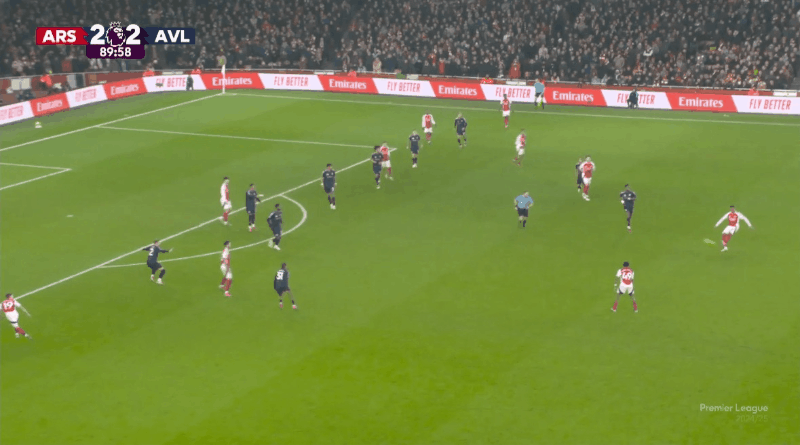


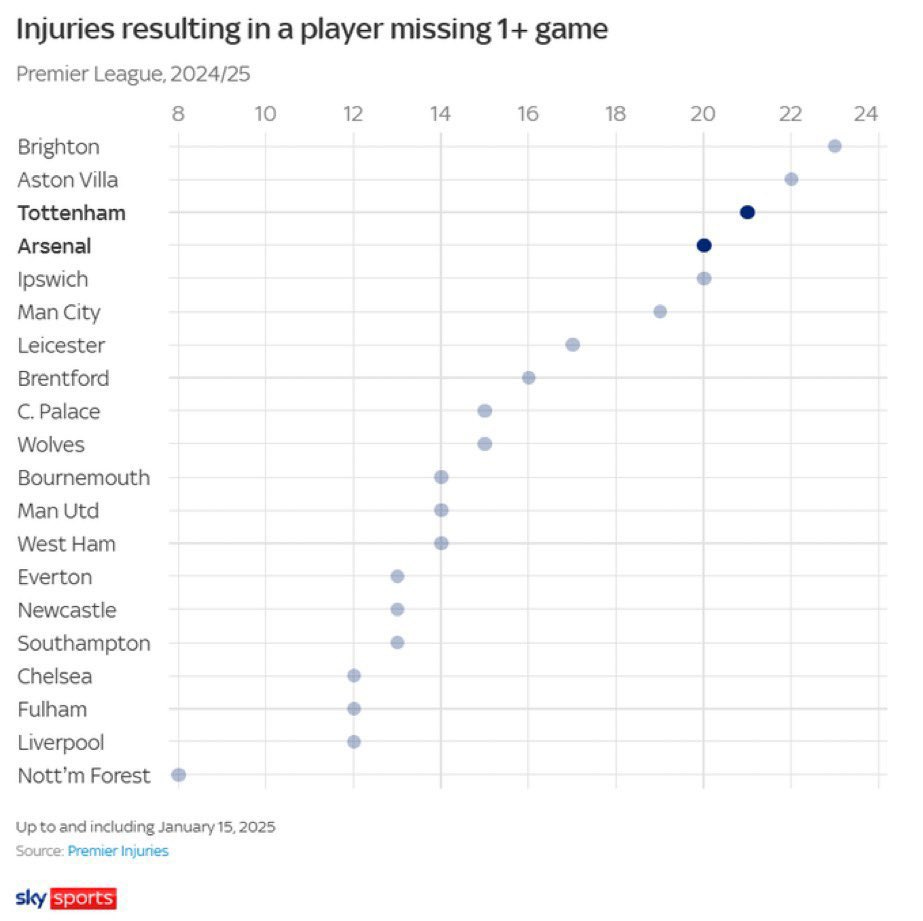

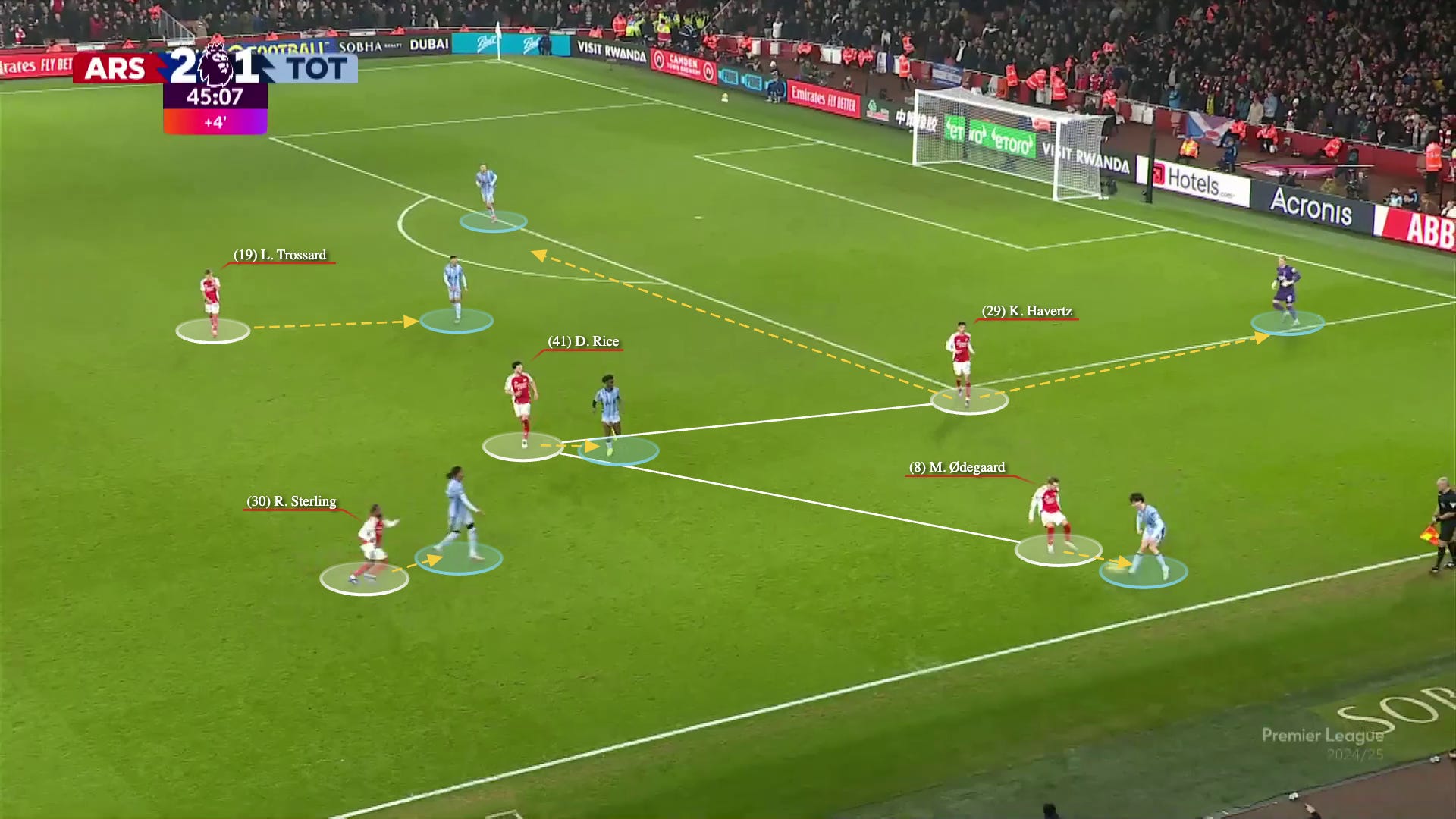






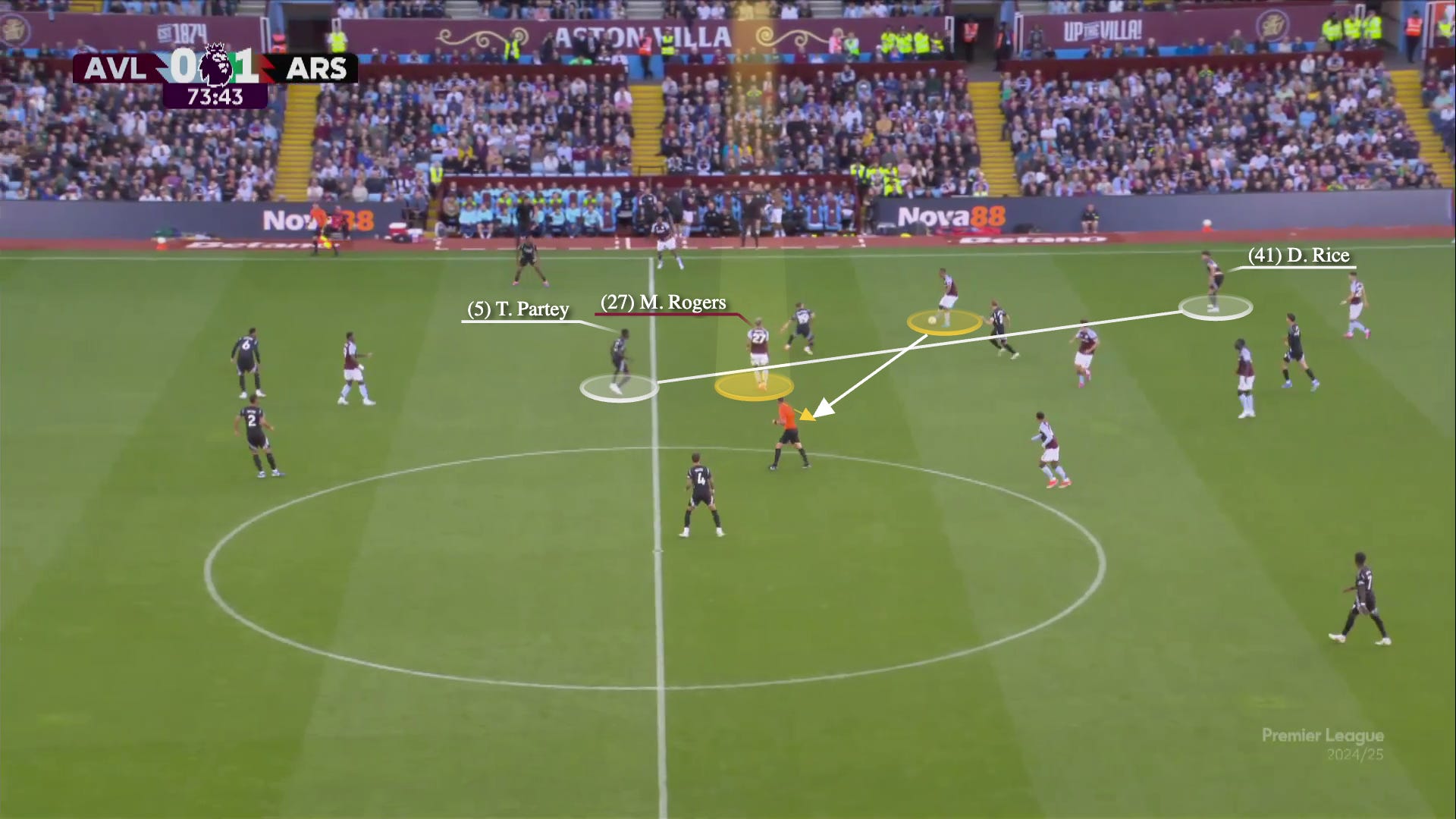









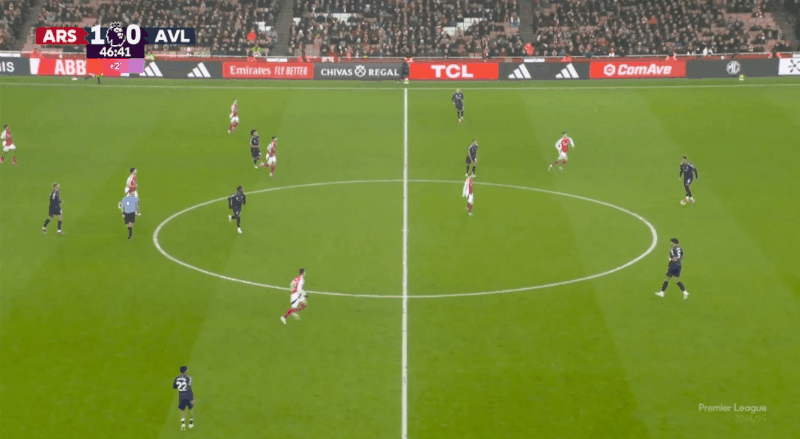
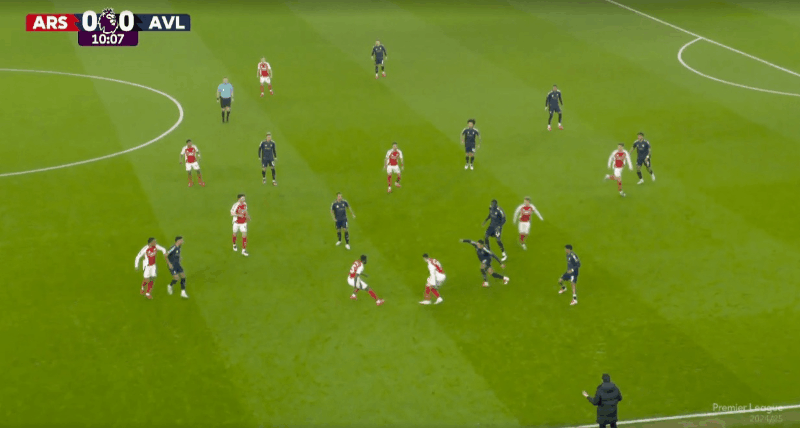





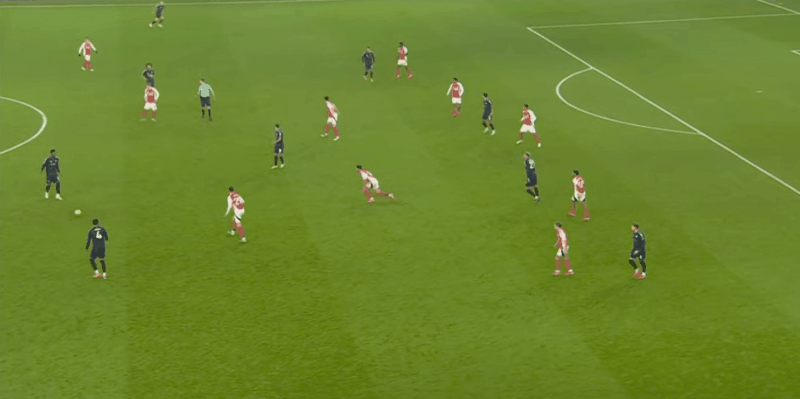
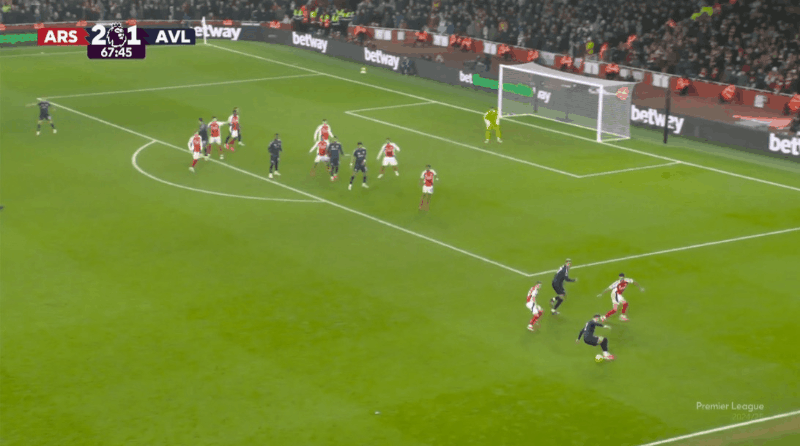
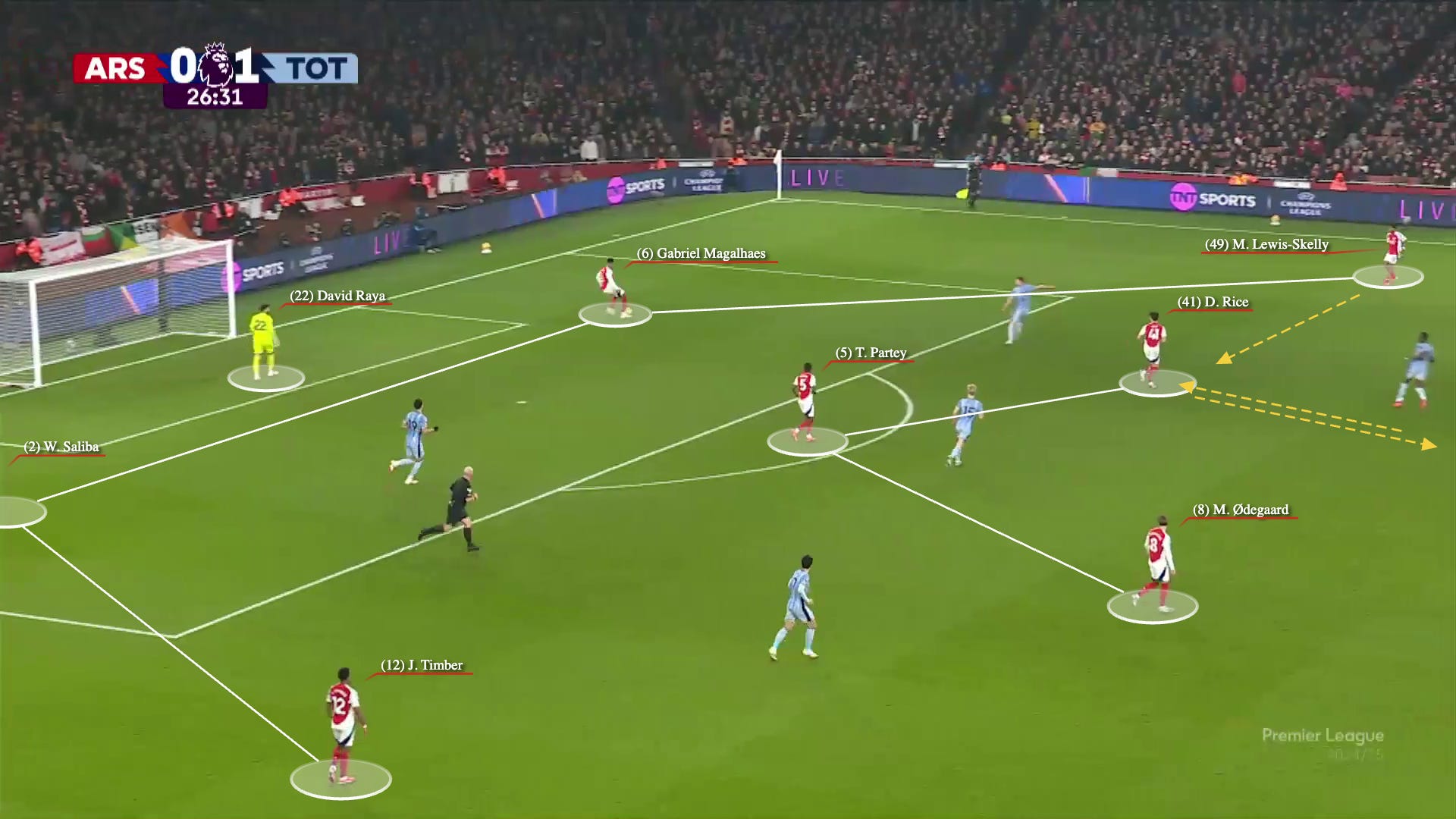




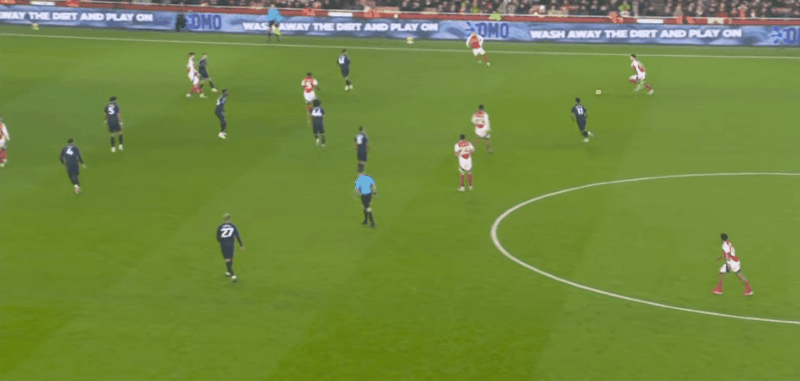


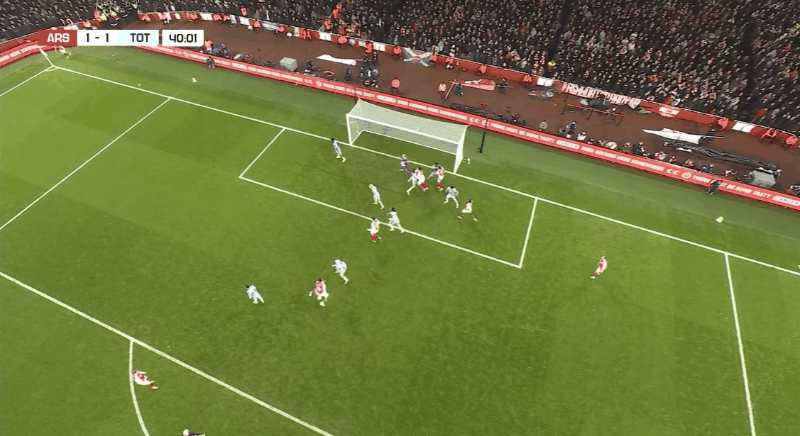







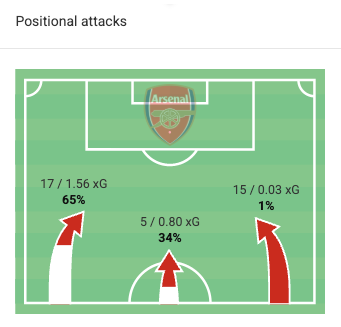





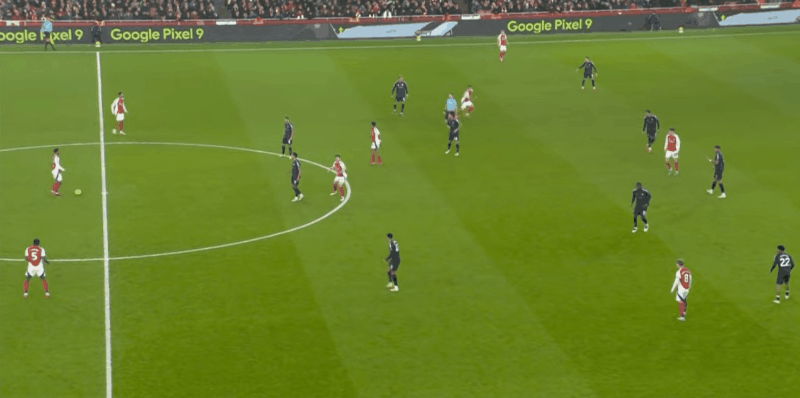


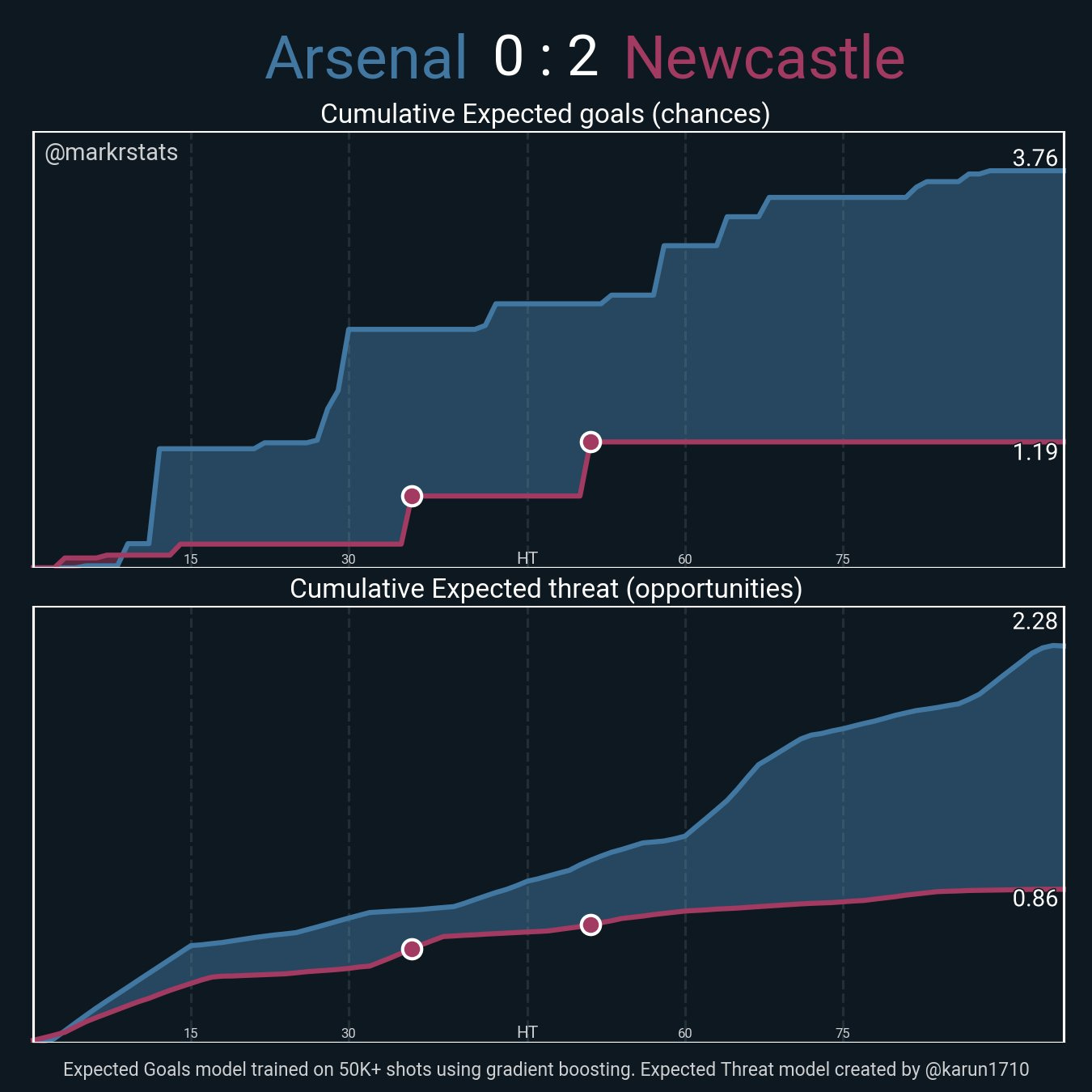









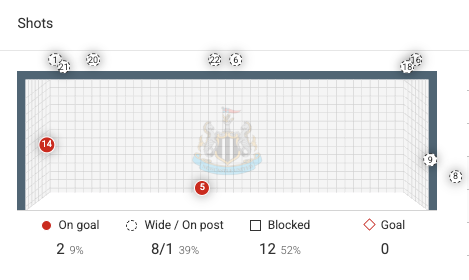



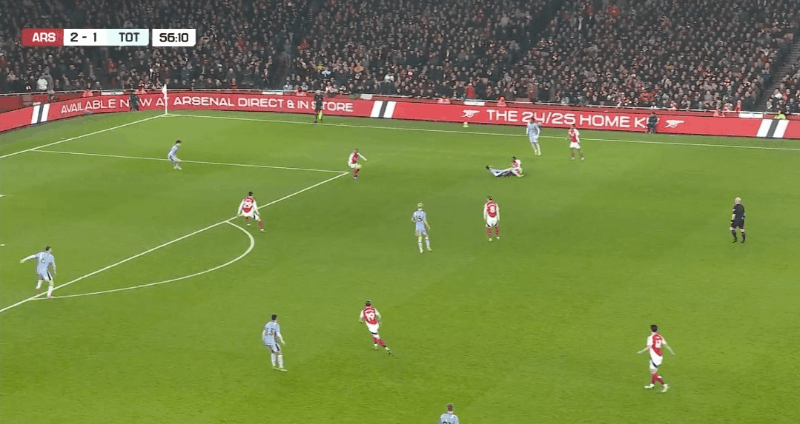




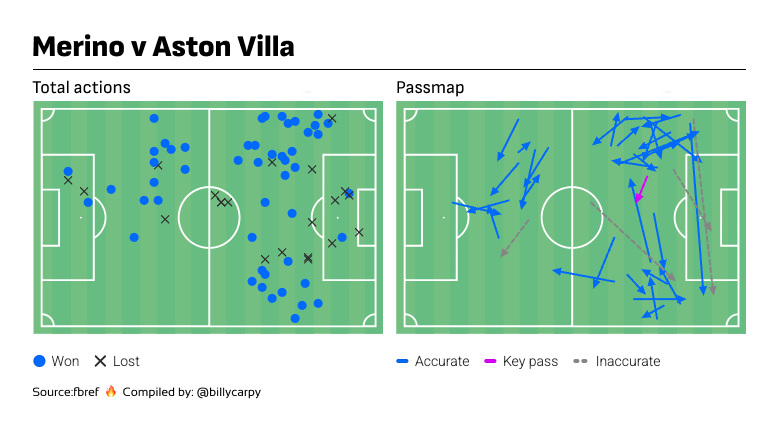
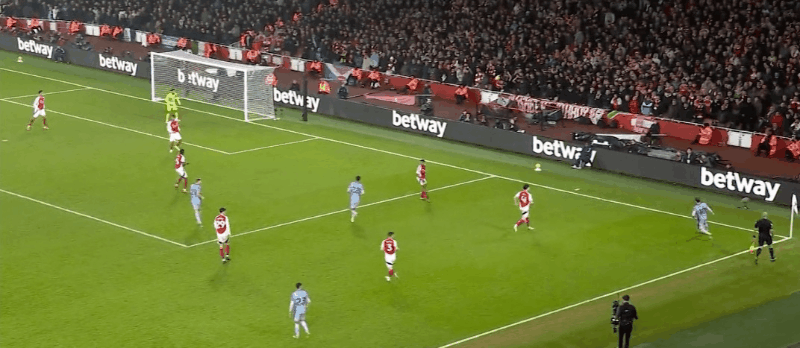
And breathe…I always feel just a bit better after reading your pieces Billy. Thanks. 1 thing I was thinking: do you think with possible additions of Zubimimendi and a Sesko(?) that Arteta is contemplating a shift to 4-2-3-1? Pairing Rice and Zubi as twin 6’s the MØ8 flanked by wide forwards left and right and an out an out no 9 up front?
Rice is a physical monster. Perfect for big champions league nights. Top 6 clashes away from home etc. He's like an anti-flat track bully. However his frankly terrible passing is a complete liability against any side we expect to dominate. He can't break the lines. He's can't hit teammates who are in on goal. That's sort of fine at 8 where his job is to steal the ball high up the pitch but playing him at 6 is often a ball progression disaster. I know you love him, but I'm surprised you never mention this. Even the clip of him here shows him knocking it miles ahead of Trossard who is in absolute acres. Jorginho and Partey are both so good at this that it's painful to watch.
I'd be interested in your thoughts.